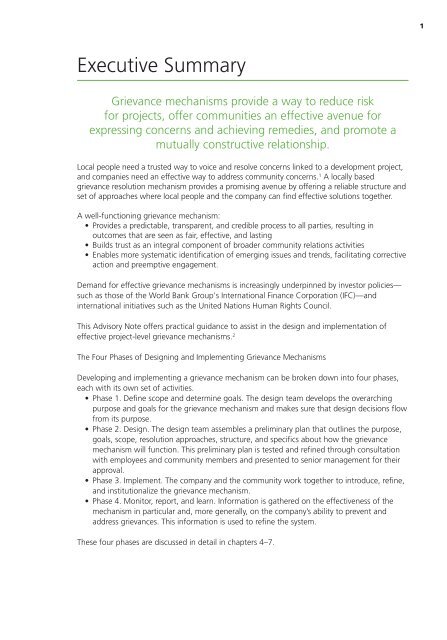A Guide to Designing and Implementing Grievance Mechanisms for ...
A Guide to Designing and Implementing Grievance Mechanisms for ...
A Guide to Designing and Implementing Grievance Mechanisms for ...
Create successful ePaper yourself
Turn your PDF publications into a flip-book with our unique Google optimized e-Paper software.
Executive Summary<br />
<strong>Grievance</strong> mechanisms provide a way <strong>to</strong> reduce risk<br />
<strong>for</strong> projects, offer communities an effective avenue <strong>for</strong><br />
expressing concerns <strong>and</strong> achieving remedies, <strong>and</strong> promote a<br />
mutually constructive relationship.<br />
Local people need a trusted way <strong>to</strong> voice <strong>and</strong> resolve concerns linked <strong>to</strong> a development project,<br />
<strong>and</strong> companies need an effective way <strong>to</strong> address community concerns. 1 A locally based<br />
grievance resolution mechanism provides a promising avenue by offering a reliable structure <strong>and</strong><br />
set of approaches where local people <strong>and</strong> the company can find effective solutions <strong>to</strong>gether.<br />
A well-functioning grievance mechanism:<br />
• Provides a predictable, transparent, <strong>and</strong> credible process <strong>to</strong> all parties, resulting in<br />
outcomes that are seen as fair, effective, <strong>and</strong> lasting<br />
• Builds trust as an integral component of broader community relations activities<br />
• Enables more systematic identification of emerging issues <strong>and</strong> trends, facilitating corrective<br />
action <strong>and</strong> preemptive engagement.<br />
Dem<strong>and</strong> <strong>for</strong> effective grievance mechanisms is increasingly underpinned by inves<strong>to</strong>r policies—<br />
such as those of the World Bank Group's International Finance Corporation (IFC)—<strong>and</strong><br />
international initiatives such as the United Nations Human Rights Council.<br />
This Advisory Note offers practical guidance <strong>to</strong> assist in the design <strong>and</strong> implementation of<br />
effective project-level grievance mechanisms. 2<br />
The Four Phases of <strong>Designing</strong> <strong>and</strong> <strong>Implementing</strong> <strong>Grievance</strong> <strong>Mechanisms</strong><br />
Developing <strong>and</strong> implementing a grievance mechanism can be broken down in<strong>to</strong> four phases,<br />
each with its own set of activities.<br />
• Phase 1. Define scope <strong>and</strong> determine goals. The design team develops the overarching<br />
purpose <strong>and</strong> goals <strong>for</strong> the grievance mechanism <strong>and</strong> makes sure that design decisions flow<br />
from its purpose.<br />
• Phase 2. Design. The design team assembles a preliminary plan that outlines the purpose,<br />
goals, scope, resolution approaches, structure, <strong>and</strong> specifics about how the grievance<br />
mechanism will function. This preliminary plan is tested <strong>and</strong> refined through consultation<br />
with employees <strong>and</strong> community members <strong>and</strong> presented <strong>to</strong> senior management <strong>for</strong> their<br />
approval.<br />
• Phase 3. Implement. The company <strong>and</strong> the community work <strong>to</strong>gether <strong>to</strong> introduce, refine,<br />
<strong>and</strong> institutionalize the grievance mechanism.<br />
• Phase 4. Moni<strong>to</strong>r, report, <strong>and</strong> learn. In<strong>for</strong>mation is gathered on the effectiveness of the<br />
mechanism in particular <strong>and</strong>, more generally, on the company’s ability <strong>to</strong> prevent <strong>and</strong><br />
address grievances. This in<strong>for</strong>mation is used <strong>to</strong> refine the system.<br />
These four phases are discussed in detail in chapters 4–7.<br />
1





